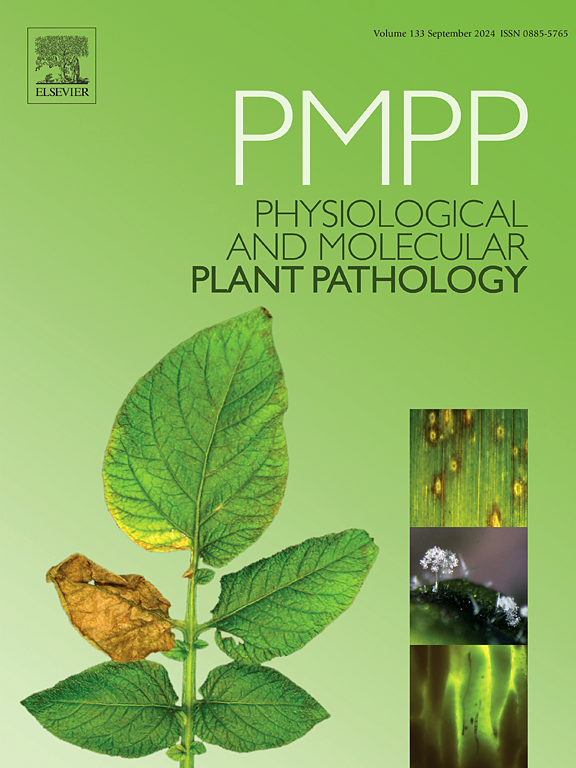Antifungal activity of 2-decanone against Monilinia fructicola and its application in combination with boscalid in mitigating brown rot disease in peach fruit
IF 2.8
3区 农林科学
Q2 PLANT SCIENCES
引用次数: 0
Abstract
Peach fruit is highly susceptible to Monilinia fructicola (M. fructicola), a pathogen that causes significant postharvest losses. Enhancing the efficacy and reducing the dosage of chemical fungicides are critical for controlling brown rot caused by M. fructicola. Natural volatile organic compounds (VOCs) have been proposed as a selective method for managing postharvest pathogen infection. Among these, 2-decanone, a natural volatile produced by fungi and insects, has demonstrated potential in inhibiting pathogen growth. In this study, 60 μL/L 2-decanone effectively inhibited the growth of M. fructicola mycelia. It also reduced spore germination and appressorium formation by downregulating the expression of MfBmp1 and MfPls1, respectively. In addition, 2-decanone induced spore apoptosis by increasing reactive oxygen species (ROS) accumulation and exacerbating mitochondrial damage. When applied to peach fruit, 2-decanone fumigation significantly reduced disease incidence and lesion diameter compared to the control group, without adversely affecting fruit quality during storage. Furthermore, we observed that 2-decanone exhibited synergistic effects when combined with boscalid, effectively inhibiting the growth of M. fructicola. Applying boscalid 15 days before harvest and fumigating with 2-decanone postharvest provided similar brown rot suppression as boscalid alone but used only one-tenth the amount of fungicide. Overall, 2-decanone fumigation presents an effective strategy for controlling postharvest brown rot disease in peaches, and its combined use with boscalid introduces a promising approach for enhancing postharvest peach fruit preservation.
2-decanone对桃褐腐病的抑菌活性及其与boscalid联合防治桃褐腐病的研究
桃果实对果霉病菌(Monilinia fructicola, m.s ucticola)非常敏感,这是一种导致重大采后损失的病原体。提高化学杀菌剂的药效和减少用量是防治果霉褐腐病的关键。天然挥发性有机化合物(VOCs)已被提出作为一种管理采后病原体感染的选择性方法。其中,真菌和昆虫产生的天然挥发物2-癸酮已被证明具有抑制病原体生长的潜力。在本实验中,60 μL/L的2-癸酮能有效抑制果支霉菌丝的生长。通过下调MfBmp1和MfPls1的表达,降低了孢子的萌发和附着胞的形成。此外,2-烯酮通过增加活性氧(ROS)积累和加重线粒体损伤来诱导孢子凋亡。与对照组相比,2-烯酮熏蒸可显著降低桃果的发病率和病变直径,且对果实贮藏品质没有不利影响。此外,我们还观察到2-癸酮与boscalid联用时表现出协同效应,有效抑制果霉的生长。采收前15天施用双碱,采收后用2-癸酮熏蒸,抑制褐腐病的效果与单施用双碱类似,但用量仅为杀菌剂的十分之一。综上所述,2-烯酮熏蒸是防治桃采后褐腐病的有效方法,与果碱联用是提高桃果实采后保鲜的有效途径。
本文章由计算机程序翻译,如有差异,请以英文原文为准。
求助全文
约1分钟内获得全文
求助全文
来源期刊
CiteScore
4.30
自引率
7.40%
发文量
130
审稿时长
38 days
期刊介绍:
Physiological and Molecular Plant Pathology provides an International forum for original research papers, reviews, and commentaries on all aspects of the molecular biology, biochemistry, physiology, histology and cytology, genetics and evolution of plant-microbe interactions.
Papers on all kinds of infective pathogen, including viruses, prokaryotes, fungi, and nematodes, as well as mutualistic organisms such as Rhizobium and mycorrhyzal fungi, are acceptable as long as they have a bearing on the interaction between pathogen and plant.

 求助内容:
求助内容: 应助结果提醒方式:
应助结果提醒方式:


